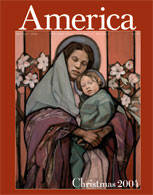In the Liturgy of the Hours, the church salutes the expected Messiah as the Orient from on high (Lk 1:78). The appellation pictures the sun rising from the East to shed its glory on a world enshrouded in darkness. The French term Levant uses the same metaphor to refer to the eastern littoral of the Mediterranean (Syria, Lebanon, Israel, Palestine and Egypt). As Christmas nears, the contrast between the hopes inspired by our celebration of the birth of the Prince of Peace and the realities of conflict in the Middle East weighs ever more heavily upon us. For the darkness that envelops the Holy Land lies like a pall over us in the United States as well.
Two and a half years ago, when the Israeli-Palestinian struggle lodged in the site of Jesus’ birth at the Basilica of the Nativity, it was hard to imagine the trouble could grow worse, but it has. With terror bombings and counterterrorist killings, collateral deaths, home demolitions, wasting of orchards and farmland, the security wall, roadblocks and border closures, the situation is more desperate than ever. Because the media satellite curtain blocks out television images of the killing and suffering in Palestinian areas, most Americans are ignorant of the depth of suffering and degradation that peace will be expected to heal.
After the passing of Yasir Arafat, pundits prophesy that peace will follow the Palestinian elections in January. Still, it would be a mistake to underestimate how difficult it will be to reverse the trends set in motion by the last five years of conflict: the growth of Israeli settlements and the assertiveness of the settler movement; the power of the Palestinian militias and the mobilization of refugee camps; the testiness and fracturing of the Israeli body politic; the demoralization of the Palestinian people and the ruination of their infrastructure; the rise in mutual suspicion and the depth of trauma on both sides. It will be far more difficult to make peace in 2005 than it was in Oslo in 1993.
To contemplate the suffering of the Holy Land from the New Rome that is the United States is a painful exercise. Rome established a peace of a sort that permitted Christianity to spread across the known world, but Herod, its client-king, made refugees of the Holy Family, and the occupation authority executed Jesus as a rebel. Under a pax americana, a U.S. administration that set out to ignore the Israeli-Palestinian conflict and cultivate the rest of the Arab world has succeeded in allowing its own client to have its way with a defeated people and in alienating the rest of the Arabs in the process.
The American non-policy is abetted by a wing of the evangelical churches that sees the expansion of the secular Jewish state of Israel as a necessary preparation for the Second Coming. The three alliesIsrael, the United States and dispensationalist evangelicalsshare a warrior theology that offers no apologies for trying to bring peace, democracy and the end time at the point of a sword. Defiantly, none marches under the nonviolent banner of the Prince of Peace. It is into this darkness of human making that the Sun of Justice must shine.
Jesus is a light to the nations, shining into the darkness for all time. Just as he gave peace to his disciples in their grieving and loss, he can give peace to all who yearn for it in the Holy Landand to those who do not as well. Christmas is a time to allow God to bestow what we ourselves fail to achieve.
On Jan. 1, the octave of Christmas, the church observes annually a World Day of Peace. This year let us mark the day with special prayers for peace, trusting that what is impossible by human effort is possible for God, both in the Holy Land and in neighboring Iraq, where U.S. responsibility is more direct and more serious. To pray for peace, as Pope John Paul has said, is to open the human heart to the inroads of God’s power to renew all things. With the life-giving force of his grace, God can create openings for peace where only obstacles and closures are apparent; he can strengthen and enlarge the solidarity of the human family in spite of our endless history of division and conflict (World Day of Peace Message, 2002).
While statesmen do what statesmen do, making peace on paper, let Christmas be the beginning of our making of peace in our hearts and in our lives. Let us do the works of peace in our homes and neighborhoods, in our cities and our country and, to the extent we can, even in the Middle East, where our nation’s policies have fashioned such painful crosses for others to bear. Filled with forgiveness and generosity, let us as far as possible, live at peace with everyone...resist evil and conquer it with good (Rom 12:18, 21). Then the Orient from on high will surely shine on us and, above all, on the peoples of the Levant themselves, like the dawning of a new day.








